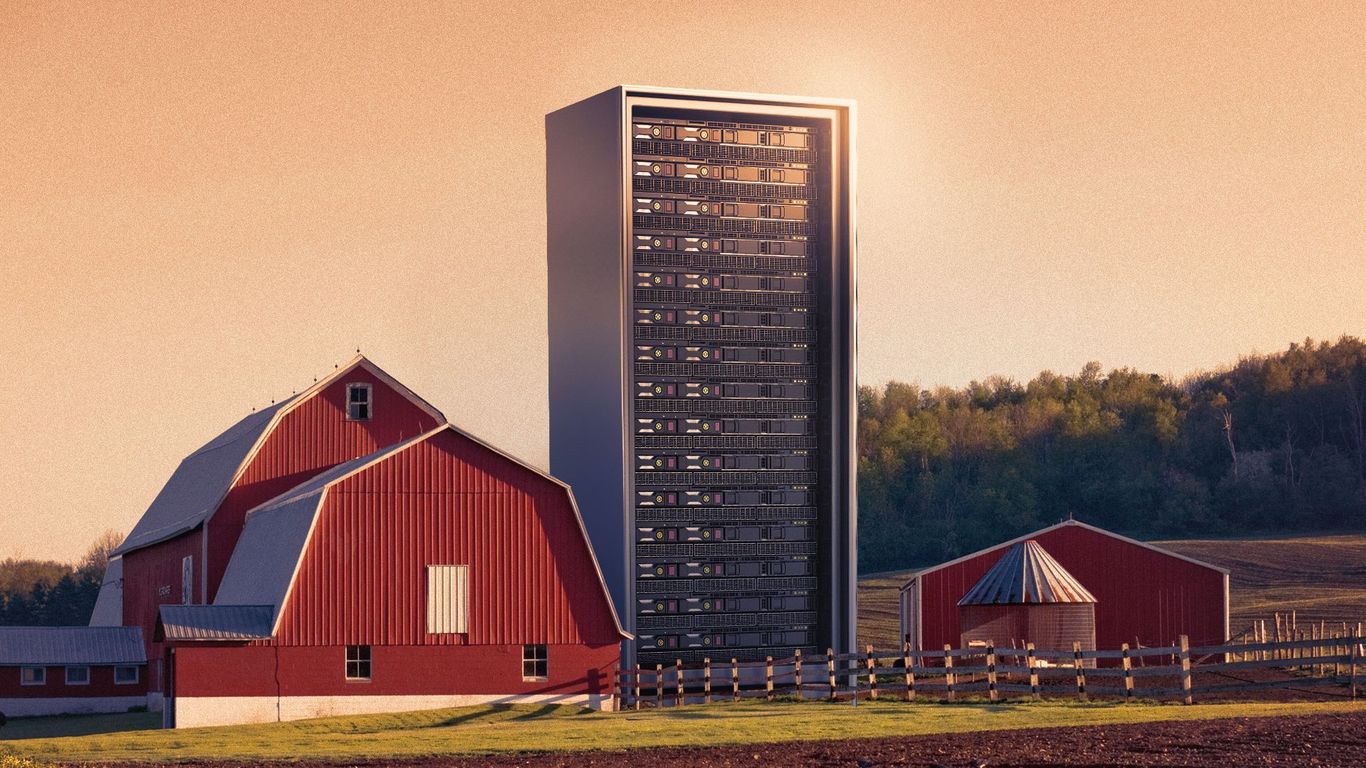The AI boom is reshaping the Midwest, driving a wave of data center development, straining energy systems, consuming millions of gallons of water — and triggering a new debate over who benefits.Why it matters: Data centers power the AI boom — but their soaring energy and water demands often go unreported, with unclear benefits for local communities and few permanent jobs created.Data centers used 4.
4% of U.S. electricity in 2023 and could consume up to 12% by 2028, per the U.

S. Department of Energy.Data center construction is at an all-time high, increasing 69% year over year from 2023 to 2024, per CBRE, a commercial real estate firm.
Yes, and: The Midwest is emerging as one of the nation's fastest-growing data center hubs, with development stretching from Kansas and Iowa to Great Lakes states like Ohio, Michigan, Indiana and Wisconsin.State of play: Columbus, Ohio, and Chicago remain the region's primary data center markets. But companies are increasingly eyeing secondary cities like Minneapolis, Pittsburgh, Des Moines and parts of Indiana, where land is cheaper and energy is more available, says Andy Cvengros of real estate firm JLL.
Cooler Midwest temperatures and proximity to the Great Lakes reduce the need for energy-intensive cooling — an advantage over warmer, Southern states.Yes, but: The expansion often happens behind closed doors.Local governments frequently sign nondisclosure agreements with tech firms, limiting public knowledge of energy and water usage, says Helena Volzer of the nonprofit Alliance for the Great Lakes.
Not even one-third of data centers track water consumption, according to a 2021 study.The other side: Our world is growing increasingly digital, and the data needs to go somewhere. U.
S. households had an average of 21 digital devices in 2023, per a Deloitte survey.As companies build to meet that surging demand, energy is a "significant cost driver," it's in their best interests to be efficient, Dan Diorio, senior director of state policy for the Data Center Coalition, tells Axios.
Data centers use unknown amounts of water and energy Illustration: Lindsey Bailey/AxiosData centers house server farms that store our information, along with electrical equipment that gets hot, requiring 24/7 air cooling that uses millions of gallons of water annually as a refrigerant.Yes, but: Volzer says their true water consumption is unknown since most rely on municipal utilities.The Great Lakes Compact is an agreement among Illinois, Indiana, Michigan, Minnesota, New York, Ohio, Pennsylvania and Wisconsin about managing the Great Lakes water basin.
Cities report to the compact how much water they're using, but that isn't broken down into details such as how much is from data centers.By the numbers: Hyperscale data centers, considered some of the largest facilities, use 365 million gallons each in a year — equivalent to what roughly 12,000 Americans use in a year, according to the Alliance for the Great Lakes.Municipalities weigh economic benefits Illustration: Lindsey Bailey/AxiosBeyond environmental costs, there's growing scrutiny over what communities get in return.
Why it matters: If leaders prioritize jobs, there are better industries for which to compete, says Peter Orazem, an economics professor at Iowa State University.But if they're counting on future property tax revenue, he says, the investment may be worth it.The big picture: A 2023 state-commissioned report in Virginia, the country's data center hub, found that while the initial construction phase delivers economic benefits, those drop off sharply once the centers are built.
Building a 250,000-square-foot data center employs up to 1,500 local employees for 12-18 months. But that declines to 50 full-time workers, half of them contracted.State of play: Most Midwest states offer data-center-specific tax credits, including a mix of sales, personal property and use-tax exemptions.
Michigan just added a sales tax exemption this year for data center equipment.Indiana and Illinois lawmakers are considering new transparency rules on data centers' energy usage.The other side: A recent Data Center Coalition report touts the economic benefits of data centers beyond the jobs inside them.
Those include bolstering supply-chain businesses, employees' spending in the community, and companies' state and local tax contributions — which come without straining public services like schools.What's nextWith rising demand and growing pushback, a regulatory reckoning may be coming. With lawmakers in Illinois and Indiana eyeing new transparency rules, advocates are watching to see whether other Midwest states follow suit.
Between the lines: It can be difficult to accurately predict future energy demand because, as time passes, systems are becoming more efficient, a 2020 study found.What's next: Cooling systems that use refrigerants instead of evaporating water are already being developed, along with better ways of recycling water.Greener power sources such as natural gas, on-site wind turbines and, perhaps eventually, small modular nuclear reactors may also alter the picture.
.
Midwest emerges as top hub in U.S. data center expansion

The AI boom is reshaping the Midwest, driving a wave of data center development, straining energy systems, consuming millions of gallons of water — and triggering a new debate over who benefits.Why it matters: Data centers power the AI boom — but their soaring energy and water demands often go unreported, with unclear benefits for local communities and few permanent jobs created.Data centers used 4.4% of U.S. electricity in 2023 and could consume up to 12% by 2028, per the U.S. Department of Energy.Data center construction is at an all-time high, increasing 69% year over year from 2023 to 2024, per CBRE, a commercial real estate firm.Yes, and: The Midwest is emerging as one of the nation's fastest-growing data center hubs, with development stretching from Kansas and Iowa to Great Lakes states like Ohio, Michigan, Indiana and Wisconsin.State of play: Columbus, Ohio, and Chicago remain the region's primary data center markets. But companies are increasingly eyeing secondary cities like Minneapolis, Pittsburgh, Des Moines and parts of Indiana, where land is cheaper and energy is more available, says Andy Cvengros of real estate firm JLL.Cooler Midwest temperatures and proximity to the Great Lakes reduce the need for energy-intensive cooling — an advantage over warmer, Southern states.Yes, but: The expansion often happens behind closed doors.Local governments frequently sign nondisclosure agreements with tech firms, limiting public knowledge of energy and water usage, says Helena Volzer of the nonprofit Alliance for the Great Lakes.Not even one-third of data centers track water consumption, according to a 2021 study.The other side: Our world is growing increasingly digital, and the data needs to go somewhere. U.S. households had an average of 21 digital devices in 2023, per a Deloitte survey.As companies build to meet that surging demand, energy is a "significant cost driver," it's in their best interests to be efficient, Dan Diorio, senior director of state policy for the Data Center Coalition, tells Axios.Data centers use unknown amounts of water and energy Illustration: Lindsey Bailey/AxiosData centers house server farms that store our information, along with electrical equipment that gets hot, requiring 24/7 air cooling that uses millions of gallons of water annually as a refrigerant.Yes, but: Volzer says their true water consumption is unknown since most rely on municipal utilities.The Great Lakes Compact is an agreement among Illinois, Indiana, Michigan, Minnesota, New York, Ohio, Pennsylvania and Wisconsin about managing the Great Lakes water basin.Cities report to the compact how much water they're using, but that isn't broken down into details such as how much is from data centers.By the numbers: Hyperscale data centers, considered some of the largest facilities, use 365 million gallons each in a year — equivalent to what roughly 12,000 Americans use in a year, according to the Alliance for the Great Lakes.Municipalities weigh economic benefits Illustration: Lindsey Bailey/AxiosBeyond environmental costs, there's growing scrutiny over what communities get in return.Why it matters: If leaders prioritize jobs, there are better industries for which to compete, says Peter Orazem, an economics professor at Iowa State University.But if they're counting on future property tax revenue, he says, the investment may be worth it.The big picture: A 2023 state-commissioned report in Virginia, the country's data center hub, found that while the initial construction phase delivers economic benefits, those drop off sharply once the centers are built.Building a 250,000-square-foot data center employs up to 1,500 local employees for 12-18 months. But that declines to 50 full-time workers, half of them contracted.State of play: Most Midwest states offer data-center-specific tax credits, including a mix of sales, personal property and use-tax exemptions.Michigan just added a sales tax exemption this year for data center equipment.Indiana and Illinois lawmakers are considering new transparency rules on data centers' energy usage.The other side: A recent Data Center Coalition report touts the economic benefits of data centers beyond the jobs inside them.Those include bolstering supply-chain businesses, employees' spending in the community, and companies' state and local tax contributions — which come without straining public services like schools.What's nextWith rising demand and growing pushback, a regulatory reckoning may be coming. With lawmakers in Illinois and Indiana eyeing new transparency rules, advocates are watching to see whether other Midwest states follow suit.Between the lines: It can be difficult to accurately predict future energy demand because, as time passes, systems are becoming more efficient, a 2020 study found.What's next: Cooling systems that use refrigerants instead of evaporating water are already being developed, along with better ways of recycling water.Greener power sources such as natural gas, on-site wind turbines and, perhaps eventually, small modular nuclear reactors may also alter the picture.















